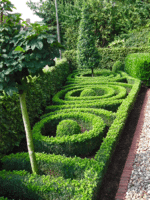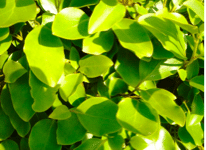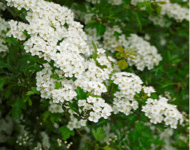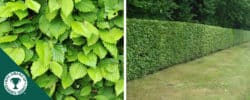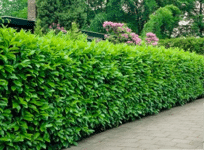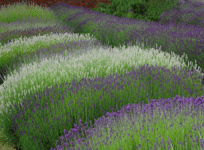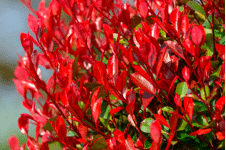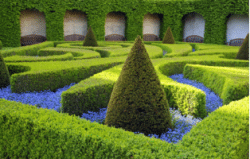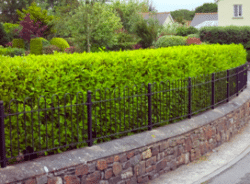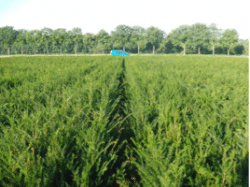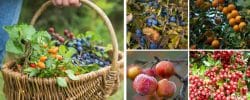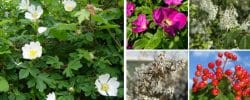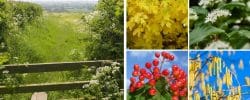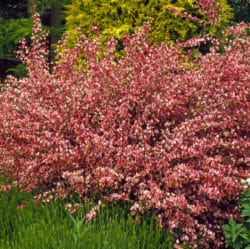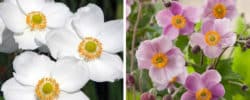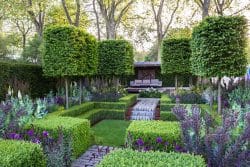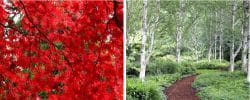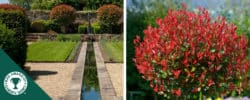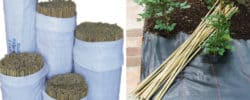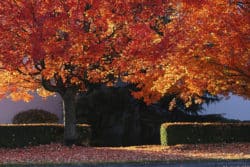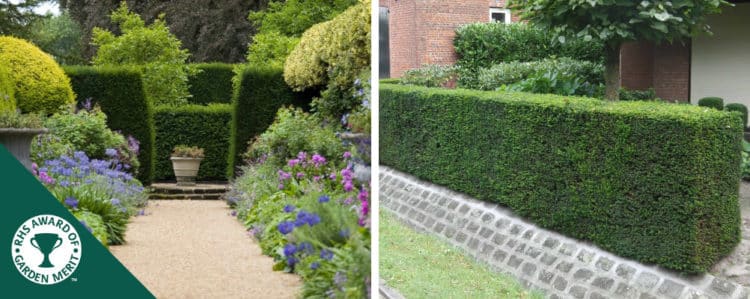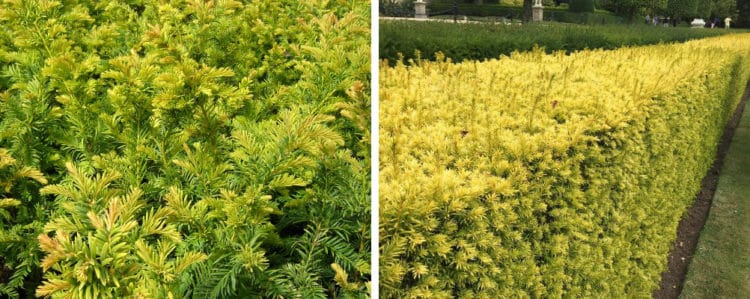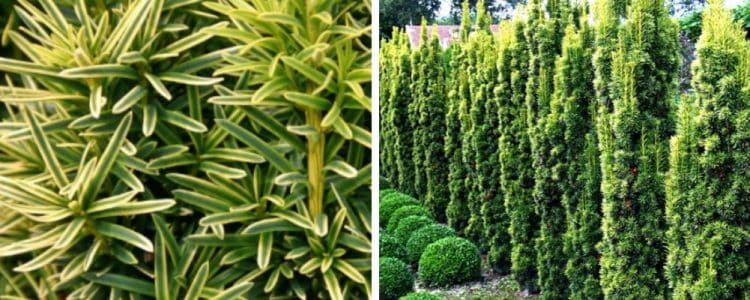Taxus Baccata hedges remain bright green throughout the spring, bloom with red-coloured fruits during the autumn, and make for a fantastic privacy hedge or topiary for your outdoor space. As a traditional British conifer, Yew hedge plants (Taxus Baccata) are a staple of many gardens across the UK and provide a stunning backdrop for colourful plants and shrubs throughout your garden.
Yew’s thick, dark green and evergreen foliage create a fantastic wall of greenery between the edge of your garden and the outside world. They make fantastic boundary hedges that reduce noise pollution in urban areas due to its thick foliage, but can also shield your garden from view, making it an ideal privacy hedge to add some security to your space.
If you’re looking for a smaller hedge to shape into formal topiary and natural garden sculptures, Yew hedges are also extremely suitable. Their slow growth rate and easy maintenance makes them ideal to grow into an unusual and awkward position that many other plant species would not be able to achieve.
How to Grow Yew Hedge Plants
Although known for its slow growth rate, Yew hedge plants aren’t as slow-growing as many believe, with the average plant gaining around 30 cm in height each year. However, it is fair to say that Yew hedging’s level of growth slows as it ages, making it easy to maintain once established in the soil and can be kept extremely tidily. Even the more modest-sized Yew plants we offer should give some coverage within a few years.
Our Yew hedging plants (Taxus Baccata) are extremely versatile. Whether you use them as tiny decorative hedges as small as 30 cm to replace a Box hedge that has succumbed to blight, or as a larger decorative hedge for screening and privacy, the possibilities are almost endless. Yew hedges can be grown up to several metres and the plants can be trained into just about any topiary shape – limited only by your imagination!
Yew hedging plants thrive once established in most situations, whether they’re in dense shade or full sunshine. The hedge is dark green in colour with red berries that are poisonous to humans and animals, and are naturally found in chalky soil areas as well as in acidic soil. It is relatively easy to maintain a yew hedge plant (Taxus Baccata hedging), as it only requires good drainage. Yew cannot tolerate water-logged soil, so it is important you consider the ability for water to drain away when planting.
In this regard Yew hedging’s are appreciated not only for their aesthetic qualities but also for their low maintenance requirements. When compared to other hedges that demand frequent pruning and attention, Yew hedges are quite undemanding.
Trimming and Maintaining Yew Hedges
New Yew hedges can be trimmed over winter and as Yew becomes a more established trim, typically in summer after the nesting season.. This timing strikes a balance between allowing new growth while avoiding harsh frosts that could damage fresh shoots. Although an annual trim is sufficient to maintain your Yew hedge’s form, you may opt for a more frequent trim to get a neatly manicured look.
If your Yew hedge becomes overgrown or unruly, you can cut it back quite severely during its dormant period (late autumn to late winter). With proper care and the addition of a suitable feed and mulch, new growth will emerge from the old wood, revitalising the hedge.
Invest in quality pruning shears or hedge trimmers to maintain your Yew hedges with precision. Ensure your tools are sharp to make clean cuts and promote healthy regrowth. Blunt shears and trimmers run the risk of crushing and damaging the hedging.
Read more yew hedging pruning advice here.
The Pest and Disease Resilience of Yew Hedging
Yew hedging is renowned for its resistance to pests and diseases, which makes it not only a captivating addition to your garden but also a remarkably resilient one. Its resilience is another of the many reasons it’s a favourite amongst gardeners and landscapers. These hedges are generally robust and capable of withstanding many common garden issues.
Pest Resistance
These hedges are remarkably resistant to common garden pests. Their dense and toxic foliage serves as a natural deterrent to many insects that might otherwise munch on your garden greenery. This innate resistance minimises the need for chemical pesticides, contributing to a healthier, eco-friendly garden.
Disease Tolerance
Yew hedging is equally robust against various diseases. They are not prone to fungal infections or other common plant diseases that can plague less hardy species. This resilience ensures your Yew hedge remains lush and green throughout the year, requiring minimal intervention to maintain its health.
Frost Resilience
It’s worth noting that occasionally, late spring frosts can lead to the blackening of emerging new shoots, although this is generally no worse than what most other evergreen hedging plants experience. The good news is that these shoots will cotypically recover within a few weeks, causing no lasting harm, and ensuring the hedge remains healthy and attractive.
The remarkable pest and disease resilience of Yew hedging makes it a prime choice for gardeners and landscapers who prefer low-maintenance landscaping. With minimal effort, you can enjoy a stunning, year-round evergreen backdrop without the worry of constant care or the use of harsh chemicals.
Common Yew Hedging Problems to Watch Out For
As previously outlined, Yew hedges are generally hardy and disease-resistant, but like all plants, they can face a few common issues that you should be aware of:
- Root Rot
- Aphid Infestations
- Pruning errors
Being informed about these problems is the first step in preventing or addressing them effectively. To find out more information on what could be causing this issue, check out our article ‘Why Is My Yew Turning Brown?‘
Why Choose Hopes Grove Nurseries?
Hopes Grove Nurseries are the leading hedge specialists, offering expert knowledge to plant growers, landscapers and garden enthusiasts for over 30 years! Our mission is to deliver the freshest, highest quality hedging plants available in the UK, delivered directly to your door for your convenience.
From rose hedges, ground cover hedges to laurel hedging, we home-grow over half a million plant species from our nursery based in Kent, the UK’s Garden of England. Each plant is tenderly grown and cared for by our dedicated staff in all weathers, 365-days a year. This is to ensure they’re in the best condition possible once they reach your garden. Take a look at our reviews on Feefo to see why our customers repeatedly use us for their yew hedging needs.
We offer helpful tips and advice to all gardeners and growers out there, giving them a helping hand to make their planting more successful. Whether you’ve opted for an instant hedge or a rootball hedge. Check out our knowledge hub for more information and planting tips.
If you think our yew hedges are of interest to you, don’t hesitate to talk to us before you buy to have any questions that you may have answered for you. Get in touch to speak to a member of our passionate, plant-loving team today.
 Bird Friendly Mixed Native Hedging
Bird Friendly Mixed Native Hedging Edible Mixed Native Hedging
Edible Mixed Native Hedging Flowering Mixed Native Hedging
Flowering Mixed Native Hedging Garden & Paddock Mixed Native Hedging
Garden & Paddock Mixed Native Hedging Gin Makers Mixed Native Hedging
Gin Makers Mixed Native Hedging Horse Friendly Hedging Plants
Horse Friendly Hedging Plants Pot Grown Mixed Hedging
Pot Grown Mixed Hedging Privacy Mixed Native Hedging
Privacy Mixed Native Hedging Species Rich Mixed Native Hedging
Species Rich Mixed Native Hedging Thornless Mixed Native Hedging
Thornless Mixed Native Hedging
